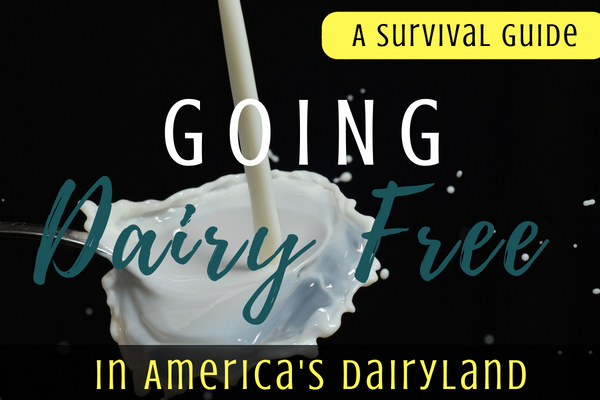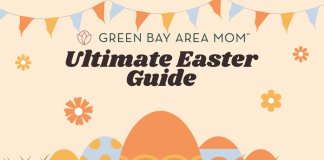 When we first decided to make the cross-country move from Alaska to Wisconsin, I was excited about all of the cheese. The squeaky cheese, the molten cheese, the gourmet cheese, the beer cheese. All of it. Fresh and readily (affordably) available. I don’t have to tell you about all the dairy delights. Fast forward a few months when my second child arrived, and we soon learned about her dairy allergy (specifically, a cow milk protein intolerance), which meant me going dairy free shortly after arriving in America’s Dairyland.
When we first decided to make the cross-country move from Alaska to Wisconsin, I was excited about all of the cheese. The squeaky cheese, the molten cheese, the gourmet cheese, the beer cheese. All of it. Fresh and readily (affordably) available. I don’t have to tell you about all the dairy delights. Fast forward a few months when my second child arrived, and we soon learned about her dairy allergy (specifically, a cow milk protein intolerance), which meant me going dairy free shortly after arriving in America’s Dairyland.
Figuring out the problem
When Baby C arrived, we were delighted. She was cute. She was alert, and we’d done this new baby thing before, so we weren’t nearly as stressed out as we had been 4 years earlier. Breastfeeding, once the tongue tie had been diagnosed and clipped, was a breeze compared with the struggles I had for the first 6 months with my son (who went on until almost 2).
But something was different. This baby cried. A lot. Back arching, lung bellowing, ear piercing screams. If I hadn’t had my son, I might have thought it was normal. However, as a semi-experienced mom, I knew it wasn’t normal behavior. And I’ll spare you the diaper details, but suffice it to say that they were gross.
I don’t eat a lot of dairy as it is (despite my delight at moving to the great state of cheese), so I soon found that her distress and screaming was far worse a few hours after I had cheese, or yogurt, or something sauteed in lots of butter. So I first decided to cut out the obvious dairy. And honestly, within 72 hours, I had a different baby. A happy baby.
We never got her tested, because we had solved the obvious problem. And it wasn’t something I needed to worry about until she got closer to age 1, which is when most babies outgrow this particular intolerance.
People say to me every day, “I don’t know how you do it.” But plain and simple, it’s not that hard to cook from scratch. And it’s a relatively easy thing to give up, especially when I saw how uncomfortable my daughter was if I got dairy’ed. So here’s what you need to know based on the past 10 months of informal research:
Dairy isn’t always obvious
Baby C immediately improved after I cut out dairy, which meant that all those freezer meals like burritos and lasagna weren’t things I could eat. And so the obvious dairy was easy to cut out. But there were still weird, unexplainable flare ups. So I knew I needed to take it to the next level and cut out all dairy. Even the hidden stuff. And let me tell you, it’s in so, much stuff. Like ramen broth and some lunch meats. French fries from McDonalds, taco seasoning, breadcrumbs, most flavored chips, and even (gasp) wine (although I admit, this was one I avoided giving up, successfully — but those with true allergies typically must avoid.)
Butter is dairy
It sounds obvious when you say it out loud, but so many people will tell you “there’s no dairy in this, I used butter instead of milk.” I joked that I became a vegan carnivore. Because I had to prepare foods vegan (i.e. no sauteeing in butter), and then add meat back in.
Non-dairy doesn’t necessarily mean dairy-free
Wait, what? Yep, so those non-dairy coffee creamers you love, check the labels. Non-dairy is able to contain a small percentage of dairy derived ingredients. It seems crazy, and it’s not always the case. Lots of popular non-dairy ice cream brands, are in fact also dairy-free.
Sheep and goats don’t moo, but you can’t trust them
Apparently the protein structure of sheep’s milk and goat’s milk is really similar to cow milk protein, and many people who can’t tolerate one, also can’t tolerate the others. So that great idea you have about feta? It may be a non-starter.
Chickens don’t moo either (and this is a good thing)
Mayo is safe, people. Lots of people may question you on this, but since mayo is derived from either eggs or olive oil, you can totally eat it.
Bring your own food everywhere
I mean everywhere. It’s not that you can’t trust family, but even when they mean well, they aren’t thinking about it as carefully as you are unless they too have the same allergy issues. It’s easy for them to add a little butter or milk to a dish (especially in Wisconsin), not thinking, and then you need to find something else to eat. A lot of the time it may be as simple of asking them to add cheese after they serve up their dish, but definitely have a back up plan in place just in case so you don’t go hungry.
Oreos are safe!
You heard it here! Those cookies with virtually no nutritional value (and a hefty dose of sugary gluten), are totally dairy free.
Scour every label, every time
I mentioned that ramen broth contains dairy. But so does some bread. And not every package, even when it’s the same brand of food, will be the same, depending on which factory it came from and if recipes have been tweaked. So what is dairy free one day, may not be dairy free the next time you buy it.
May contain isn’t always a deal breaker
May contain is essentially a cross-contamination warning. If you’re dealing with a fully blown allergy, then it’s a choice that you’ll have to make with your doctor. But for many who are “only” dealing with an intolerance, it just means that the factory also produces products with dairy (or wheat, or soy, or gluten, etc) on the same lines, and they can’t guarantee that your food is completely free of dairy as a result.
Don’t be afraid to grill your server
Eating out gets tough. Really tough. So we tried to stick to allergy-friendly places or places that don’t have much dairy in the first place. But don’t be afraid to call ahead before you go. And don’t be afraid to ask your server to double check, or even ask for a manager or chef who knows the ingredients well. It feels awkward, especially if you’ve never had food issues before, but it’s worth it for your health (and sanity).
More on eating out
Types of restaurants where we’ve had good luck tend to be either on the smaller side, or on the big corporate side. Big restaurant chains often have an allergy menu that tells you what types of particular allergens are in their ingredients. So you can often look them up before you go, or ask to see the allergy menu when you get there. Smaller family owned restaurants can also be really friendly, even if you order a vegan meal and then add meat to it. And a lot of ethnic restaurants that don’t use a lot of dairy in their normal cuisine can be great…think Mongolian barbecue, or sushi (skip the rolls with cream cheese, or ask that they not be made with it).
See an allergist for a plan
So cutting out the dairy is all fine and dandy. And honestly after you’ve done it for a while, it’s not that hard to do, and it’s a relatively minor sacrifice to go dairy free, even in Wisconsin. But how do you start reintroducing it if your baby is getting old enough? Some people suggest a dairy ladder to introduce it to the baby once they’re 9 months or so. I chose to get a referral to an allergist, who answered all of my questions, and gave me a solid plan moving forward given my daughter’s reactions and severity of symptoms. I walked out of there confident, more confident than I had been in MONTHS.
Be kind to yourself
Especially if you’re cutting dairy as an adult, and cutting it all out, there’s a big learning curve. And some lessons you learn the hard way. What I’m saying is you will slip up. If you’re a mom giving up dairy because you’re breastfeeding and your new baby has an intolerance or an allergy, be kind to yourself. You will slip up. It’s pretty much not a matter of if, but when. And yes, it hurts your heart, but it happens, so keep moving forward through it.
The bottom line
Going dairy free isn’t always easy, and there’s a lot you need to know. But it’s not nearly as complicated as it may feel like. You’re not stuck eating chicken and rice for the rest of your life. Nor are you stuck eating expensive non-dairy dairy free foods. There are work arounds and substitutions for just about everything. And sometimes it just means getting a little creative. So rest assured, whether you’re going dairy free in America’s Dairyland by choice or out of necessity, you can do this. And, you’re far from alone!


















Thank you for the article! You’re doing AMAZING things for you & your baby!!
I recently was diagnosed with both gluten & dairy allergies. I feel so much better since eliminating them. I love cooking with Avocado oil & ghee (clarified butter that is DELICIOUS!!) Almond & cashew milk are delicious (as is coconut milk, but I’m allergic ?). I make my own cream cheese from silk almond yogurt & DF cheese cake from raw cashews. (Thank you Pinterest!!) Thankfully most products now have listed allergens that I look at first, then I read all ingredients.
Comments are closed.